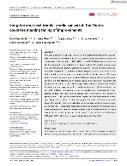Long-term survival trends in solid cancers in the Nordic countries marking timing of improvements

Autor
Försti, Asta
Kanerva, Anna
Hemminki, Otto
Hemminki, Akseli
Datum vydání
2023Publikováno v
International Journal of CancerRočník / Číslo vydání
152 (9)ISBN / ISSN
ISSN: 0020-7136Metadata
Zobrazit celý záznamKolekce
Tato publikace má vydavatelskou verzi s DOI 10.1002/ijc.34416
Abstrakt
Survival studies are an important indicator of the success of cancer control. We analyzed the 5-year relative survival in 23 solid cancers in Denmark, Finland, Norway and Sweden over a 50-year period (1970-2019) at the NORDCAN database accessed from the International Agency for Research on Cancer website. We plotted survival curves in 5-year periods and showed 5-year periodic survival. The survival results were summarized in four groups: (1) cancers with historically good survival (>50% in 1970-1974) which include melanoma and breast, endometrial and thyroid cancers; (2) cancers which constantly improved survival at least 20% units over the 50 year period, including cancers of the stomach, colon, rectum, kidney, brain and ovary; (3) cancer with increase in survival >20% units with changes taking place in a narrow time window, including oral, oropharyngeal, testicular and prostate cancers; (4) the remaining cancers with <20% unit improvement in survival including lung, esophageal, liver, pancreatic, bladder, soft tissue, penile, cervical and vulvar cancers. For cancers in groups 1 and 2, the constant development implied multiple improvements in therapy, diagnosis and patient care. Cancers in group 3 included testicular cancers with known therapeutic improvements but for the others large incidence changes probably implied that cancer stage (prostate) or etiology (oropharynx) changed into a more tractable form. Group 4 cancers included those with dismal survival 50 years ago but a clear tendency upwards. In 17 cancers 5-year survival reached between 50% and 100% while in only six cancers it remained at below 50%.
Klíčová slova
early diagnosis, periodic survival, prognosis, relative survival, treatment
Trvalý odkaz
https://hdl.handle.net/20.500.14178/1957Licence
Licence pro užití plného textu výsledku: Creative Commons Uveďte původ-Neužívejte dílo komerčně 4.0 International







